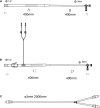The application of modular multifunctional left heart bypass circuit system integrated with ultrafiltration in thoracoabdominal aortic aneurysm repair
- PMID: 36211541
- PMCID: PMC9534546
- DOI: 10.3389/fcvm.2022.944287
The application of modular multifunctional left heart bypass circuit system integrated with ultrafiltration in thoracoabdominal aortic aneurysm repair
Abstract
Open thoracoabdominal aortic aneurysm (TAAA) repair is a complex and challenging operation with a high incidence of serious complications, and high perioperative mortality and morbidity. Left heart bypass (LHB) is a circulatory support system used to perfuse the distal aorta during TAAA operation, and the advantages of LHB include guaranteeing distal perfusion, reducing the use of heparin, and diminishing the risk of bleeding and postoperative neurological deficits. In China, the circuit for TAAA repair is deficient, and far from the perfusion requirements. We designed a modular multifunctional LHB circuit for TAAA repair. The modular circuit consisted of cannulation pipelines, functional consumables connection pipelines, and accessory pipelines. The accessory pipelines make up lines for selective visceral perfusion and kidney perfusion, suckers and rapid infusion. The circuit can be assembled according to surgical requirements. The ultrafilter and heat exchanger are integrated into the circuit to fulfill the basic demands of LHB. The LHB circuit also has pipelines for selective visceral perfusion to the celiac artery and superior mesenteric artery and renal perfusion pipelines. Meanwhile, the reserved pipelines facilitate the quick switch from LHB to conventional cardiopulmonary bypass (CPB). The reserved pipelines reduce the time of reassembling the CPB circuit. Moreover, the rapid infusion was integrated into the LHB circuit, which can rapid infusion when massive hemorrhage during the open procedures such as exposure and reconstruction of the aorta. The ultrafiltration can diminish the consequent hemodilution of hemorrhage and rapid infusion. A hemoperfusion cartridge also can be added to reduce the systemic inflammatory during operation. The circuit can meet the needs of LHB and quickly switch to conventional CPB. No oxygenator was required during LHB, which reduce the use of heparin and reduce the risk of bleeding. The heat exchanger contributes to temperature regulation; ultrafiltration, arterial filter, and rapid-infusion facilitated the blood volume management and are useful to maintain hemodynamic stability. This circuit made the assembly of the LHB circuit more easily, and more efficient, which may contribute to the TAAA repair operation performed in lower volume centers easily. 26 patients who received TAAA repair under the modular multifunctional LHB from January 2018-March 2022 were analyzed, and we achieved acceptable clinical outcomes. The in-hospital mortality and 30-day postoperative mortality were 15.4%, and the postoperative incidences of paraparesis (4%), stroke (4%), and AKI need hemodialysis (12%) were not particularly high, based on the limited patients sample size in short research period duration.
Keywords: cardiopulmonary bypass; hospital volume; kidney protection; left heart bypass; selective visceral perfusion; spinal cord protection; thoracoabdominal aortic aneurysm repair.
Copyright © 2022 Huang, Chen, Hu, Luo, Hu, Duan, Wang, Ye and Zhang.
Conflict of interest statement
The authors declare that the research was conducted in the absence of any commercial or financial relationships that could be construed as a potential conflict of interest.
Figures






Similar articles
-
Spinal Cord Protection of Aorto-Iliac Bypass in Open Repair of Extent II and III Thoracoabdominal Aortic Aneurysm.Heart Lung Circ. 2022 Feb;31(2):255-262. doi: 10.1016/j.hlc.2021.05.092. Epub 2021 Jul 6. Heart Lung Circ. 2022. PMID: 34244065
-
The use of left heart bypass in the repair of thoracoabdominal aortic aneurysms: current techniques and results.Semin Thorac Cardiovasc Surg. 2003 Oct;15(4):326-32. doi: 10.1053/s1043-0679(03)00090-x. Semin Thorac Cardiovasc Surg. 2003. PMID: 14710373 Review.
-
[Comparative study of hypothermic circulatory arrest and normothermic distal perfusion for thoracoabdominal aortic aneurysm repair].Kyobu Geka. 2003 Mar;56(3):175-80; discussion 180-2. Kyobu Geka. 2003. PMID: 12649906 Japanese.
-
Thoracoabdominal aneurysmectomy: Operative steps for Crawford extent II repair.JTCVS Tech. 2020 Jun 25;3:25-36. doi: 10.1016/j.xjtc.2020.06.028. eCollection 2020 Sep. JTCVS Tech. 2020. PMID: 34317802 Free PMC article.
-
Surgical repair of thoracoabdominal aortic aneurysms.J Cardiovasc Surg (Torino). 2007 Feb;48(1):49-58. J Cardiovasc Surg (Torino). 2007. PMID: 17308522 Review.
Cited by
-
Kidney protection during surgery on the thoracoabdominal aorta: a systematic review.Interdiscip Cardiovasc Thorac Surg. 2025 Mar 29;40(4):ivaf093. doi: 10.1093/icvts/ivaf093. Interdiscip Cardiovasc Thorac Surg. 2025. PMID: 40215187 Free PMC article.
-
Long-term outcomes of extensive thoracoabdominal aortic aneurysm repair utilizing normothermic iliac perfusion: a retrospective cohort study with 10-year single-center experience.Int J Surg. 2025 Jan 1;111(1):728-736. doi: 10.1097/JS9.0000000000001858. Int J Surg. 2025. PMID: 38954673 Free PMC article.
-
Innovation in pathogenesis and management of aortic aneurysm.World J Exp Med. 2024 Jun 20;14(2):91408. doi: 10.5493/wjem.v14.i2.91408. eCollection 2024 Jun 20. World J Exp Med. 2024. PMID: 38948412 Free PMC article. Review.
-
Modified Circuit for Left-Sided Heart Bypass in Thoracoabdominal Surgery.Ann Thorac Surg Short Rep. 2023 Sep 13;2(1):21-24. doi: 10.1016/j.atssr.2023.09.003. eCollection 2024 Mar. Ann Thorac Surg Short Rep. 2023. PMID: 39790259 Free PMC article.
References
LinkOut - more resources
Full Text Sources

